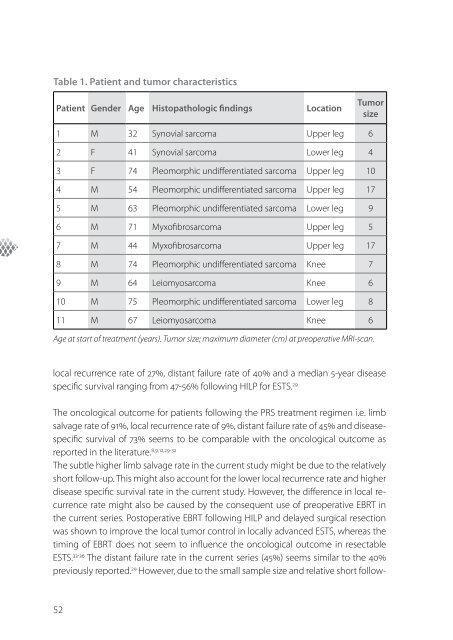Stevenson boek digi
Create successful ePaper yourself
Turn your PDF publications into a flip-book with our unique Google optimized e-Paper software.
3. A new limb saving treatment strategy for locally advanced sarcomas<br />
Table 1. Patient and tumor characteristics<br />
Patient Gender Age Histopathologic findings Location<br />
1 M 32 Synovial sarcoma Upper leg 6<br />
2 F 41 Synovial sarcoma Lower leg 4<br />
Tumor<br />
size<br />
3 F 74 Pleomorphic undifferentiated sarcoma Upper leg 10<br />
4 M 54 Pleomorphic undifferentiated sarcoma Upper leg 17<br />
5 M 63 Pleomorphic undifferentiated sarcoma Lower leg 9<br />
6 M 71 Myxofibrosarcoma Upper leg 5<br />
7 M 44 Myxofibrosarcoma Upper leg 17<br />
8 M 74 Pleomorphic undifferentiated sarcoma Knee 7<br />
9 M 64 Leiomyosarcoma Knee 6<br />
10 M 75 Pleomorphic undifferentiated sarcoma Lower leg 8<br />
11 M 67 Leiomyosarcoma Knee 6<br />
Age at start of treatment (years). Tumor size; maximum diameter (cm) at preoperative MRI-scan.<br />
local recurrence rate of 27%, distant failure rate of 40% and a median 5-year disease<br />
specific survival ranging from 47-56% following HILP for ESTS. 29<br />
The oncological outcome for patients following the PRS treatment regimen i.e. limb<br />
salvage rate of 91%, local recurrence rate of 9%, distant failure rate of 45% and diseasespecific<br />
survival of 73% seems to be comparable with the oncological outcome as<br />
reported in the literature. 8,9,12,29-32<br />
The subtle higher limb salvage rate in the current study might be due to the relatively<br />
short follow-up. This might also account for the lower local recurrence rate and higher<br />
disease specific survival rate in the current study. However, the difference in local recurrence<br />
rate might also be caused by the consequent use of preoperative EBRT in<br />
the current series. Postoperative EBRT following HILP and delayed surgical resection<br />
was shown to improve the local tumor control in locally advanced ESTS, whereas the<br />
timing of EBRT does not seem to influence the oncological outcome in resectable<br />
ESTS. 33-36 The distant failure rate in the current series (45%) seems similar to the 40%<br />
previously reported. 29 However, due to the small sample size and relative short follow-<br />
Table 2. Complications following PRS treatment<br />
PRS<br />
(n=11)<br />
Complication<br />
grade according<br />
to Clavien-Dindo 22<br />
Total amount of complications n=14 I-IIIb<br />
Medical 3 (21%)<br />
• Urinary tract infection 1 II<br />
• Urinary retention 2 I<br />
Surgical 11 (79%)<br />
• Seroma 2 I<br />
• Rash following melphalan administration 1 I<br />
• Wound infection needing intravenous antibiotics 1 II<br />
• Deep venous thrombosis 1 II<br />
• Cellulitis needing intravenous antibiotics 3 II<br />
• Wound infection 1 IIIb<br />
• Partial flap loss 2 IIIb<br />
Patients developing a complication 10 (91%)<br />
Patients developing a major wound complication 3 (27%)<br />
Major wound complication: wound complication occurring during treatment or



